2011 VOLKSWAGEN TRANSPORTER wiper fluid
[x] Cancel search: wiper fluidPage 116 of 486
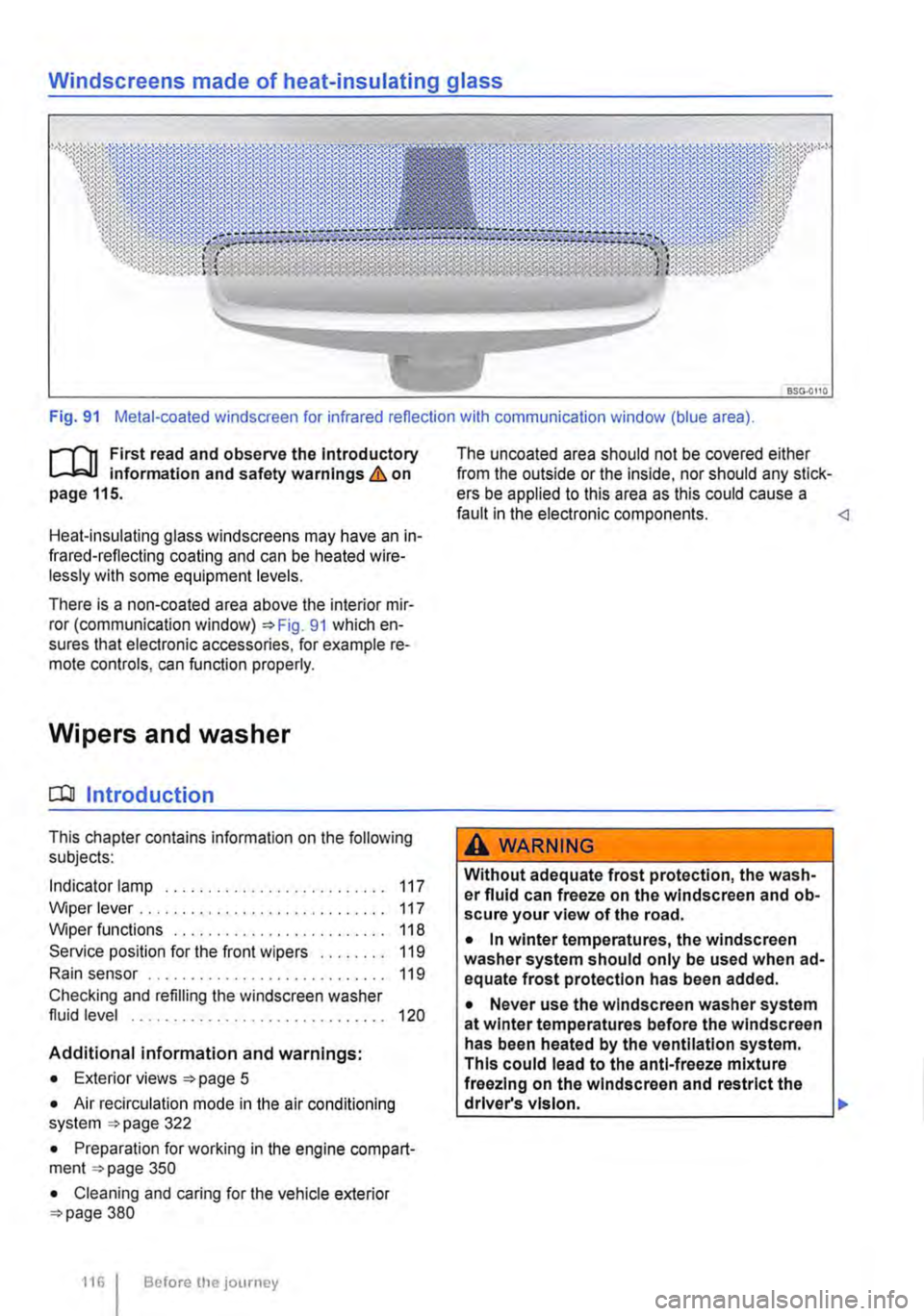
Windscreens made of heat-insulating glass
Fig. 91 Metal-coated windscreen for infrared reflection with communication window (blue area).
r-111 First read and observe the Introductory L-W.! Information and safety warnings & on page 115.
Heat-insulating glass windscreens may have an in-frared-reflecting coating and can be heated wire-lessly with some equipment levels.
There is a non-coated area above the interior mir-ror (communication window) 91 which en-sures that electronic accessories, for example re-mote controls, can function properly.
Wipers and washer
CQJ Introduction
This chapter contains information on the following subjects:
Indicator lamp . . . . . . . . . . . . . . . . . . . . . . . 117
Wiper lever . . . . . . . . . . . . . . . . . . . . . . . . . . . . . 117 Wiper functions . . . . . . . . . . 118 Service position for the front wipers . . . . . . . . 119
Rain sensor . . . . . . . . . . . . . . . . . . . . 119
Checking and refilling the windscreen washer fluid level . . . . . . . . . . . . . . . . . . . . . . . . . . . . . . 120
Additional information and warnings:
• Exterior views page 5
• Air recirculation mode in the air conditioning system 322
• Preparation for working in the engine compart-ment page 350
• Cleaning and caring for the vehicle exterior 380
116 I Before the journey
The uncoated area should not be covered either from the outside or the inside, nor should any stick-ers be applied to this area as this could cause a fault in the electronic components.
Without adequate frost protection, the wash-er fluid can freeze on the windscreen and ob-scure your view of the road.
• In winter temperatures, the windscreen washer system should only be used when ad-equate frost protection has been added.
• Never use the windscreen washer system at winter temperatures before the windscreen has been heated by the ventilation system. This could lead to the anti-freeze mixture freezing on the windscreen and restrict the driver's vision. .,.
Page 117 of 486
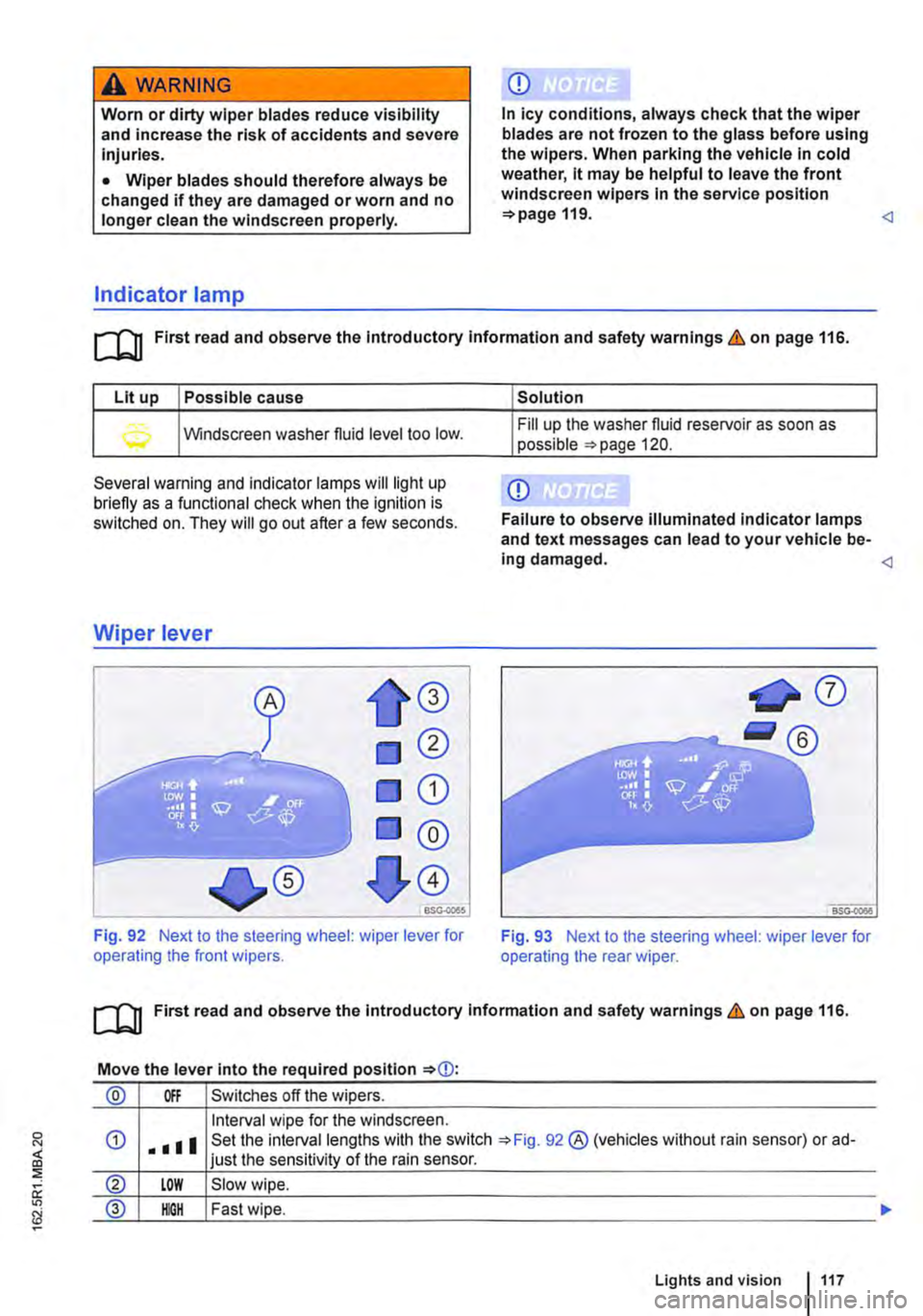
A WARNING
Worn or dirty wiper blades reduce visibility and increase the risk of accidents and severe injuries.
• Wiper blades should therefore always be changed if they are damaged or worn and no longer clean the windscreen properly.
Indicator lamp
Q)
In icy conditions, always check that the wiper blades are not frozen to the glass before using the wipers. When parking the vehicle in cold weather, it may be helpful to leave the front windscreen wipers in the service position 119.
Lit up Possible cause
Windscreen washer fluid level too low.
Several warning and indicator lamps will light up briefly as a functional check when the ignition is switched on. They will go out after a few seconds.
Wiper lever
Fig. 92 Next to the steering wheel: wiper lever for operating the front wipers.
Solution
Fill up the washer fluid reservoir as soon as possible =>page 120.
Q)
Failure to observe illuminated indicator lamps and text messages can lead to your vehicle be-ing damaged.
[QJ First read and observe the introductory information and safety warnings & on page 116.
Move the lever into the required position
® Off Switches off the wipers.
Interval wipe for the windscreen.
® LOW Slow wipe.
@ IOOH Fast wipe.
Lights and vision 117
Page 118 of 486
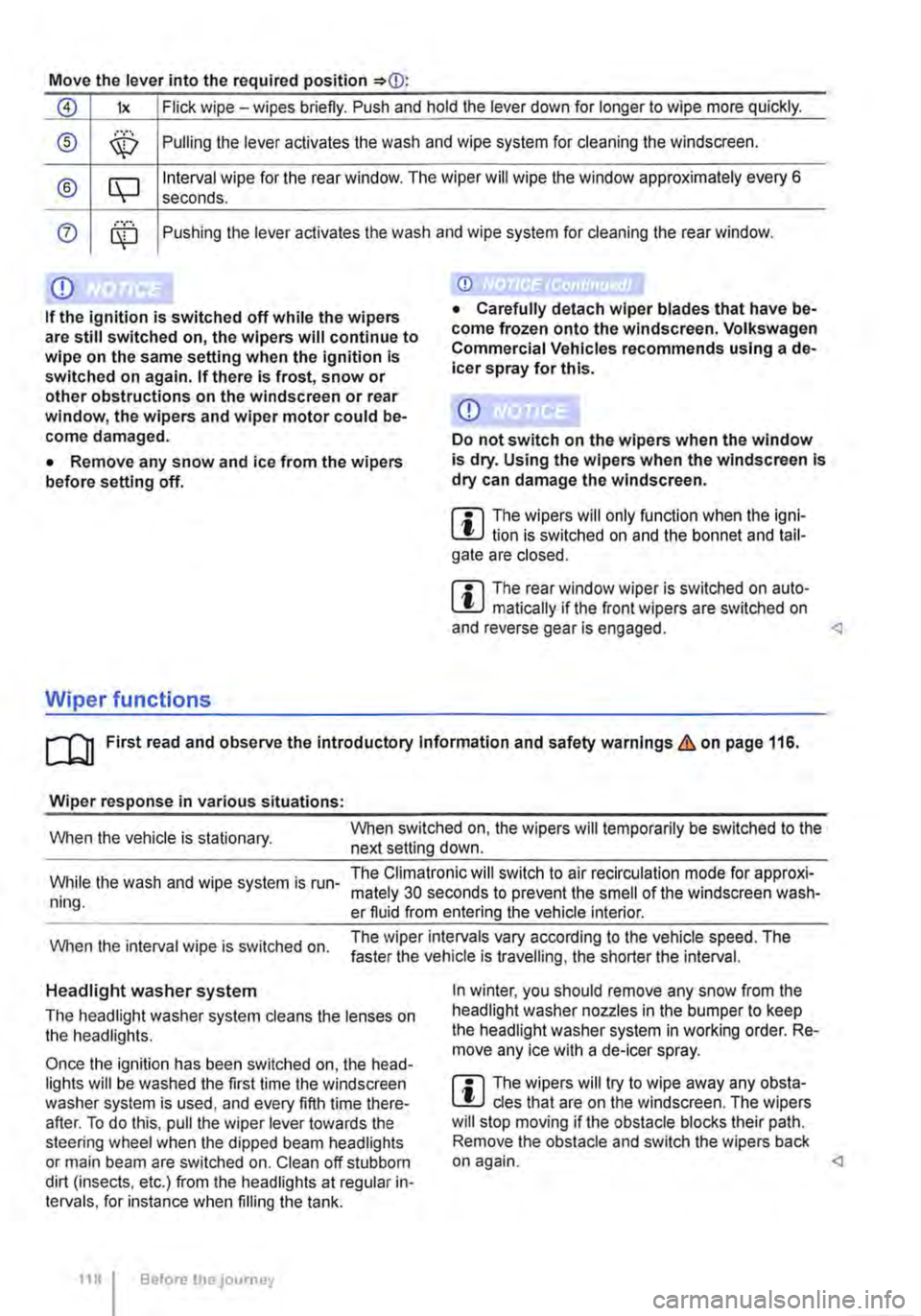
Move the lever into the required position
0 lx Flick wipe -wipes briefly. Push and hold the lever down for longer to wipe more quickly.
® ,··.··· \X:) Pulling the lever aclivates the wash and wipe system for cleaning the windscreen.
® CQ Interval wipe for the rear window. The wiper will wipe the window approximately every 6 seconds .
0 ........ Pushing the lever activates the wash and wipe system for cleaning the rear window.
Q)
If the ignition is switched off while the wipers are still switched on, the wipers will continue to wipe on the same setting when the ignition Is switched on again. If there Is frost, snow or other obstructions on the windscreen or rear window, the wipers and wiper motor could be-come damaged.
• Remove any snow and ice from the wipers before setting off.
Wiper functions
Q)
Do not switch on the wipers when the window is dry. Using the wipers when the windscreen Is dry can damage the windscreen.
m The wipers will only function when the igni-W lion is switched on and the bonnet and tail-gate are closed.
m The rear window wiper is switched on auto-W matically if the front wipers are switched on and reverse gear is engaged.
Wiper response in various situations:
When the vehicle is stationary. When switched on, the wipers will temporarily be switched to the next setting down.
While the wash and wipe system is run-ning.
The Climatronic will switch to air recirculation mode for approxi-mately 30 seconds to prevent the smell of the windscreen wash-er fluid from entering the vehicle interior.
When the interval wipe is switched on. The wiper intervals vary according to the vehicle speed. The faster the vehicle is travelling, the shorter the interval.
Headlight washer system
The headlight washer system cleans the lenses on the headlights.
Once the ignition has been switched on, the head-lights will be washed the first time the windscreen washer system is used, and every fifth time there-after. To do this, pull the wiper lever towards the steering wheel when the dipped beam headlights or main beam are switched on. Clean off stubborn dirt (insects, etc.) from the headlights at regular in-tervals, for instance when filling the tank.
118 Before the journey
In winter, you should remove any snow from the headlight washer nozzles in the bumper to keep the headlight washer system in working order. Re-move any ice with a de-icer spray.
m The wipers will try to wipe away any obsta-W cles that are on the windscreen. The wipers will stop moving if the obstacle blocks their path. Remove the obstacle and switch the wipers back on again.
Page 120 of 486
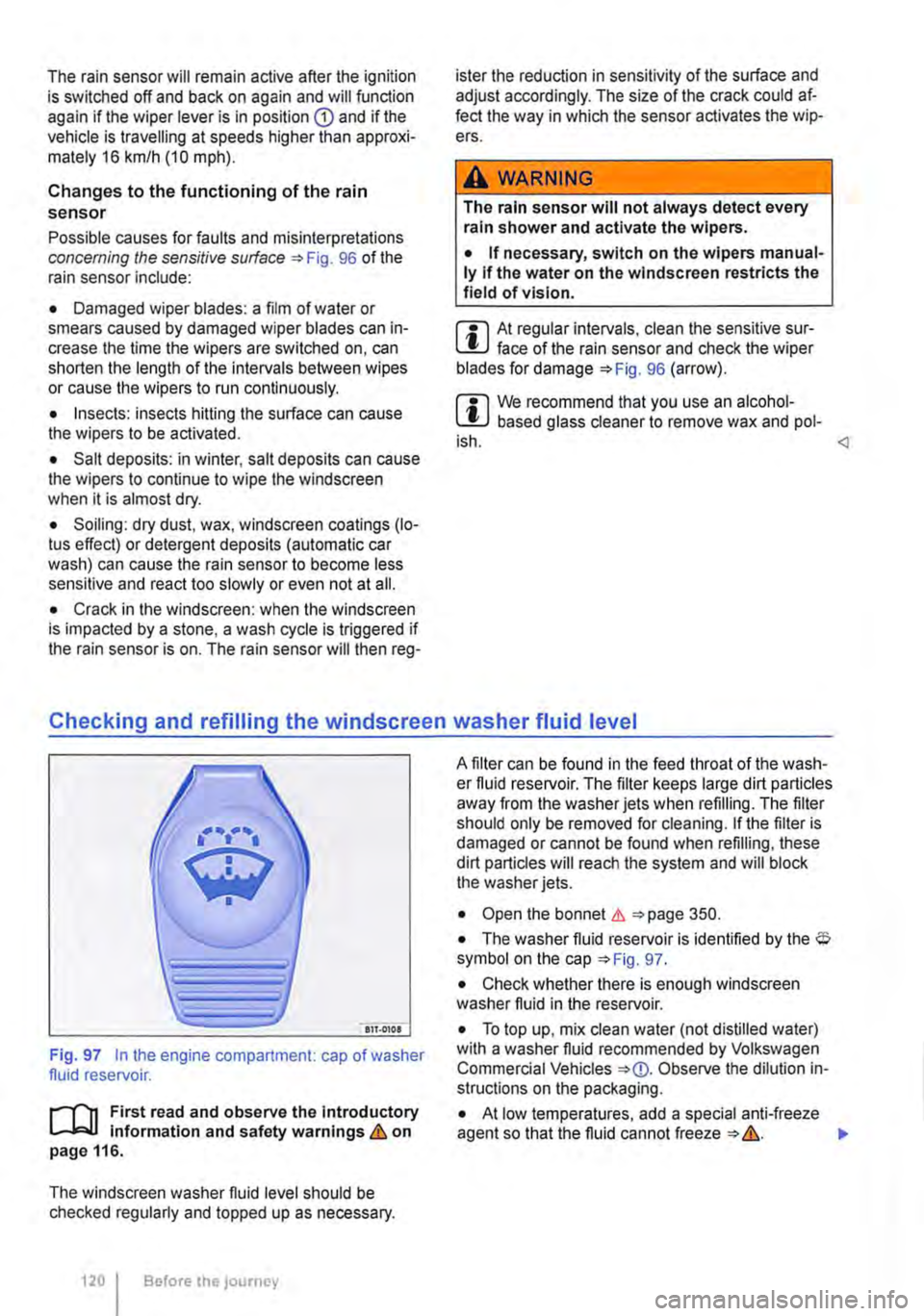
The rain sensor will remain active after the ignition is switched off and back on again and will function again if the wiper lever is in position G) and if the vehicle is travelling at speeds higher than approxi-mately 16 km/h (10 mph).
Changes to the functioning of the rain sensor
Possible causes for faults and misinterpretations concerning the sensitive surface 96 of the rain sensor include:
• Damaged wiper blades: a film of water or smears caused by damaged wiper blades can in-crease the time the wipers are switched on, can shorten the length of the intervals between wipes or cause the wipers to run continuously.
• Insects: insects hitting the surface can cause the wipers to be activated.
• Salt deposits: in winter, salt deposits can cause the wipers to continue to wipe the windscreen when it is almost dry.
• Soiling: dry dust, wax, windscreen coatings (lo-tus effect) or detergent deposits (automatic car wash) can cause the rain sensor to become less sensitive and react too slowly or even not at all.
• Crack in the windscreen: when the windscreen is impacted by a stone, a wash cycle is triggered if the rain sensor is on. The rain sensor will then reg-
ister the reduction in sensitivity of the surface and adjust accordingly. The size of the crack could af-fect the way in which the sensor activates the wip-ers.
A WARNING
The rain sensor will not always detect every rain shower and activate the wipers.
• If necessary, switch on the wipers manual-ly if the water on the windscreen restricts the field of vision.
m At regular intervals, clean the sensitive sur-L!...J face of the rain sensor and check the wiper blades for damage 96 (arrow).
m We recommend that you use an alcohoi-W based glass cleaner to remove wax and pol-ish.
Checking and refilling the windscreen washer fluid level
Fig. 97 In the engine compartment: cap of washer fluid reservoir.
r--T'n First read and observe the introductory L-J,:,JJ information and safety warnings & on page 116.
The windscreen washer fluid level should be checked regularly and topped up as necessary.
120 I Before the journey
A filter can be found in the feed throat of the wash-er fluid reservoir. The filter keeps large dirt particles away from the washer jets when refilling. The filter should only be removed for cleaning. if the filter is damaged or cannot be found when refilling, these dirt particles will reach the system and will block the washer jets.
• Open the bonnet & 350.
• The washer fluid reservoir is identified by the $ symbol on the cap 97.
• Check whether there is enough windscreen washer fluid in the reservoir.
• To top up, mix clean water (not distilled water) with a washer fluid recommended by Volkswagen Commercial Vehicles Observe the dilution in-structions on the packaging.
• At low temperatures, add a special anti-freeze agent so that the fluid cannot freeze &.
Page 350 of 486
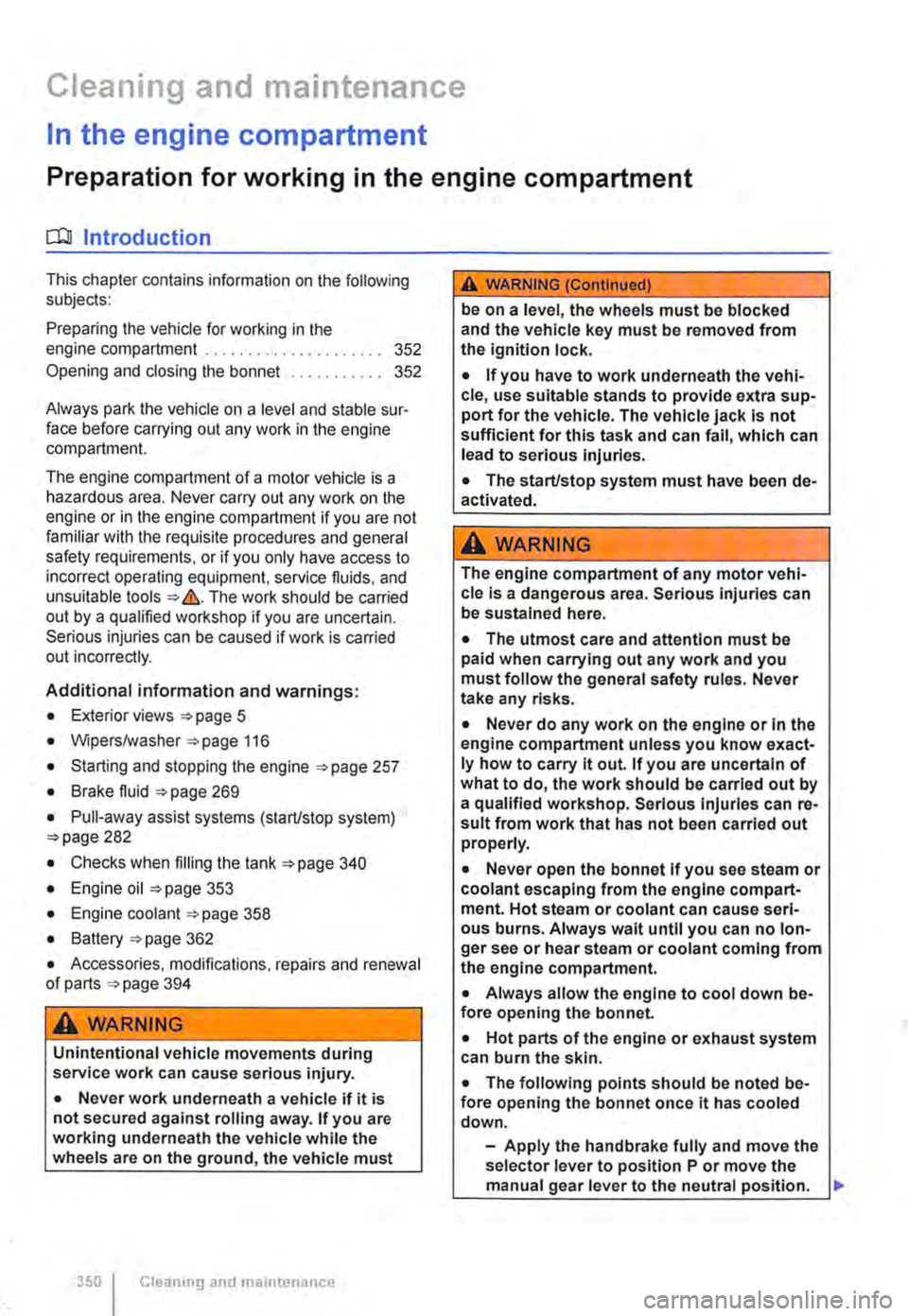
Cleaning and maintenance
In the engine compartment
Preparation for working in the engine compartment
ClJ Introduction
This chapter contains information on the following subjects:
Preparing the vehicle for working in the engine compartment . . . . . . . . . . . . . . . . . 352 Opening and closing the bonnet 352
Always park the vehicle on a level and stable sur-face before carrying out any work in the engine compartment.
The engine compartment of a motor vehicle is a hazardous area. Never carry out any work on the engine or in the engine compartment if you are not familiar with the requisite procedures and general safety requirements, or if you only have access to incorrect operating equipment, service fluids, and unsuitable tools &. The work should be carried out by a qualified workshop if you are uncertain. Serious injuries can be caused if work is carried out incorrectly.
Additional information and warnings:
• Exterior views 5
• Wipers/washer 116
• Starting and stopping the engine 257
• Brake fluid 269
• Pull-away assist systems (starUstop system) 282
• Checks when filling the tank 340
• Engine oil 353
• Engine coolant 358
• Battery page 362
• Accessories, modifications, repairs and renewal of parts 394
A wARNING
Unintentional vehicle movements during service work can cause serious injury.
• Never work underneath a vehicle if it is not secured against rolling away. If you are working underneath the vehicle while the wheels are on the ground, the vehicle must
350 I Cleanmg and maintenance
A WARNING (Continued)
be on a level, the wheels must be blocked and the vehicle key must be removed from the ignition lock.
• If you have to work underneath the vehi-cle, use suitable stands to provide extra sup-port for the vehicle. The vehicle jack is not sufficient for this task and can fail, which can lead to serious injuries.
• The start/stop system must have been de-activated.
A WARNING
The engine compartment of any motor vehi-cle is a dangerous area. Serious injuries can be sustained here.
• The utmost care and attention must be paid when carrying out any work and you must follow the general safety rules. Never take any risks.
• Never do any work on the engine or in the engine compartment unless you know exact-ly how to carry it out. If you are uncertain of what to do, the work should be carried out by a qualified workshop. Serious Injuries can re-sult from work that has not been carried out properly.
• Never open the bonnet if you see steam or coolant escaping from the engine compart-ment. Hot steam or coolant can cause seri-ous burns. Always wait until you can no lon-ger see or hear steam or coolant coming from the engine compartment.
• Always allow the engine to cool down be-fore opening the bonnet.
• Hot parts of the engine or exhaust system can burn the skin.
• The following points should be noted be-fore opening the bonnet once it has cooled down.
-Apply the handbrake fully and move the selector lever to position P or move the manual gear lever to the neutral position. .,..
Page 380 of 486
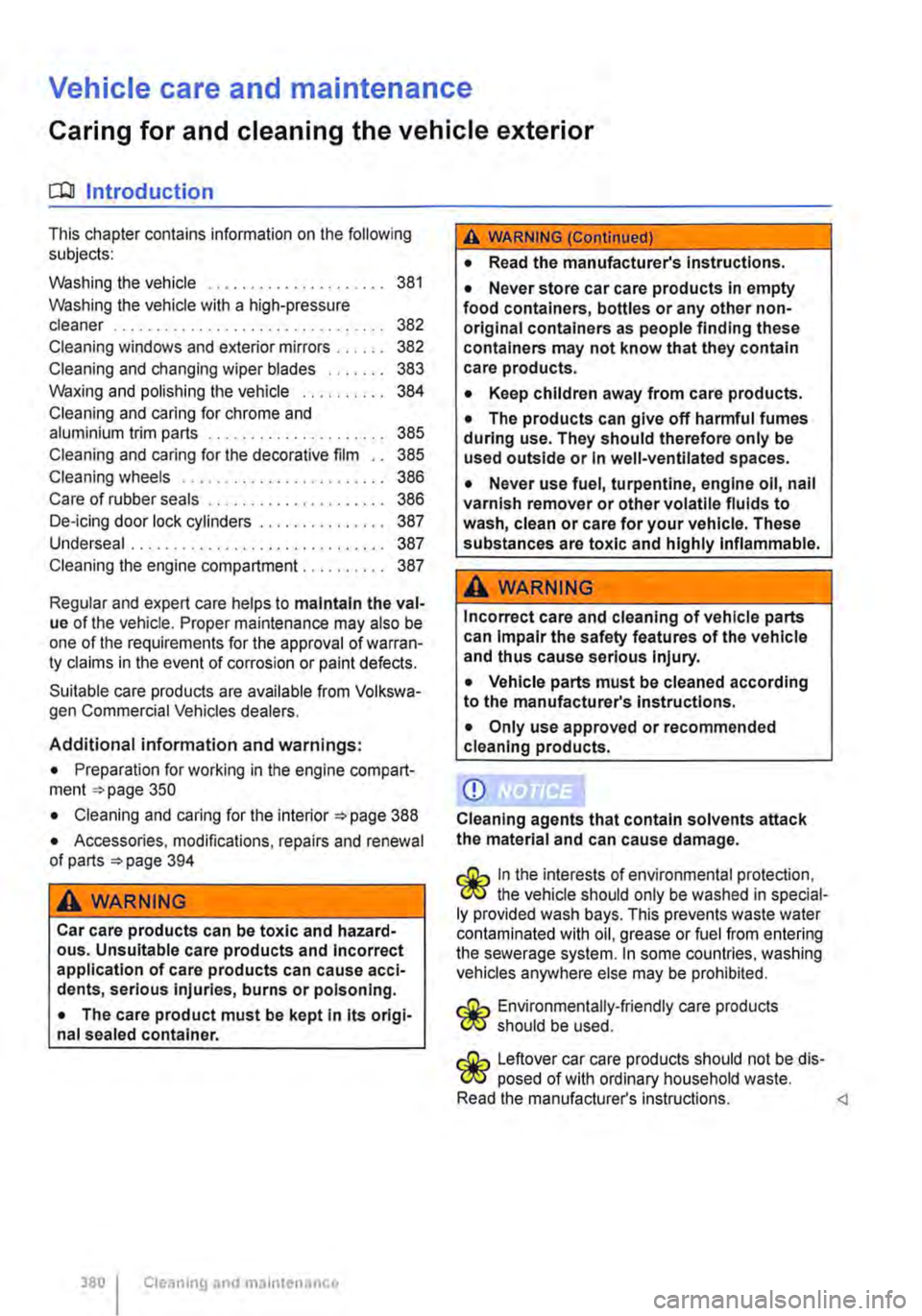
Vehicle care and maintenance
Caring for and cleaning the vehicle exterior
o:n Introduction
This chapter contains information on the following subjects:
Washing the vehicle . . . . . . . . . . . . . . . 381
Washing the vehicle with a high-pressure cleaner . . . . . . . . . . . . . . . . . . . . . . . . . . . 382 Cleaning windows and exterior mirrors . . . . . . 382
Cleaning and changing wiper blades 383
Waxing and polishing the vehicle 384
Cleaning and caring for chrome and aluminium trim parts . . . . . . . . . . . . . . 385
Cleaning and caring for the decorative film . . 385
Cleaning wheels . . . . . . . . . . . . . . . . . . . . . 386
Care of rubber seals . . . . . . . . . . . . . . . . . . . . . 386
De-icing door lock cylinders . . . . . . • . . . . . . . . 387
Undersea! . . . . . . . . . . . . . . . . . . . . . . . . . . . . . . 387
Cleaning the engine compartment . 387
Regular and expert care helps to maintain the val-ue of the vehicle. Proper maintenance may also be one of the requirements for the approval of warran-ty claims in the event of corrosion or paint defects.
Suitable care products are available from Volkswa-gen Commercial Vehicles dealers.
Additional information and warnings:
• Preparation for working in the engine compart-ment ::-page 350
• Cleaning and caring for the interior ::-page 388
• Accessories, modifications, repairs and renewal of parts ::-page 394
A WARNING
Car care products can be toxic and hazard-ous. Unsuitable care products and Incorrect application of care products can cause acci-dents, serious Injuries, burns or poisoning.
• The care product must be kept In Its origi-nal sealed container.
380 Cleaning and maintenance
A WARNING (Continued)
• Read the manufacturer's Instructions .
• Never store car care products in empty food containers, bottles or any other non-original containers as people finding these containers may not know that they contain care products.
• Keep children away from care products .
• The products can give off harmful fumes during use. They should therefore only be used outside or In well-ventilated spaces.
• Never use fuel, turpentine, engine oil, nail varnish remover or other volatile fluids to wash, clean or care for your vehicle. These substances are toxic and highly Inflammable.
A WARNING
Incorrect care and cleaning of vehicle parts can Impair the safety features of the vehicle and thus cause serious Injury.
• Vehicle parts must be cleaned according to the manufacturer's Instructions.
• Only use approved or recommended cleaning products.
CD
Cleaning agents that contain solvents attack the material and can cause damage.
r:Q:... In the interests of environmental protection, "C!S the vehicle should only be washed in special-ly provided wash bays. This prevents waste water contaminated with oil, grease or fuel from entering the sewerage system. In some countries, washing vehicles anywhere else may be prohibited.
r:Q:... Environmentally-friendly care products "C!S should be used.
r:Q:... Leftover car care products should not be dis-"C!S posed of with ordinary household waste. Read the manufacturer's instructions.
Page 383 of 486
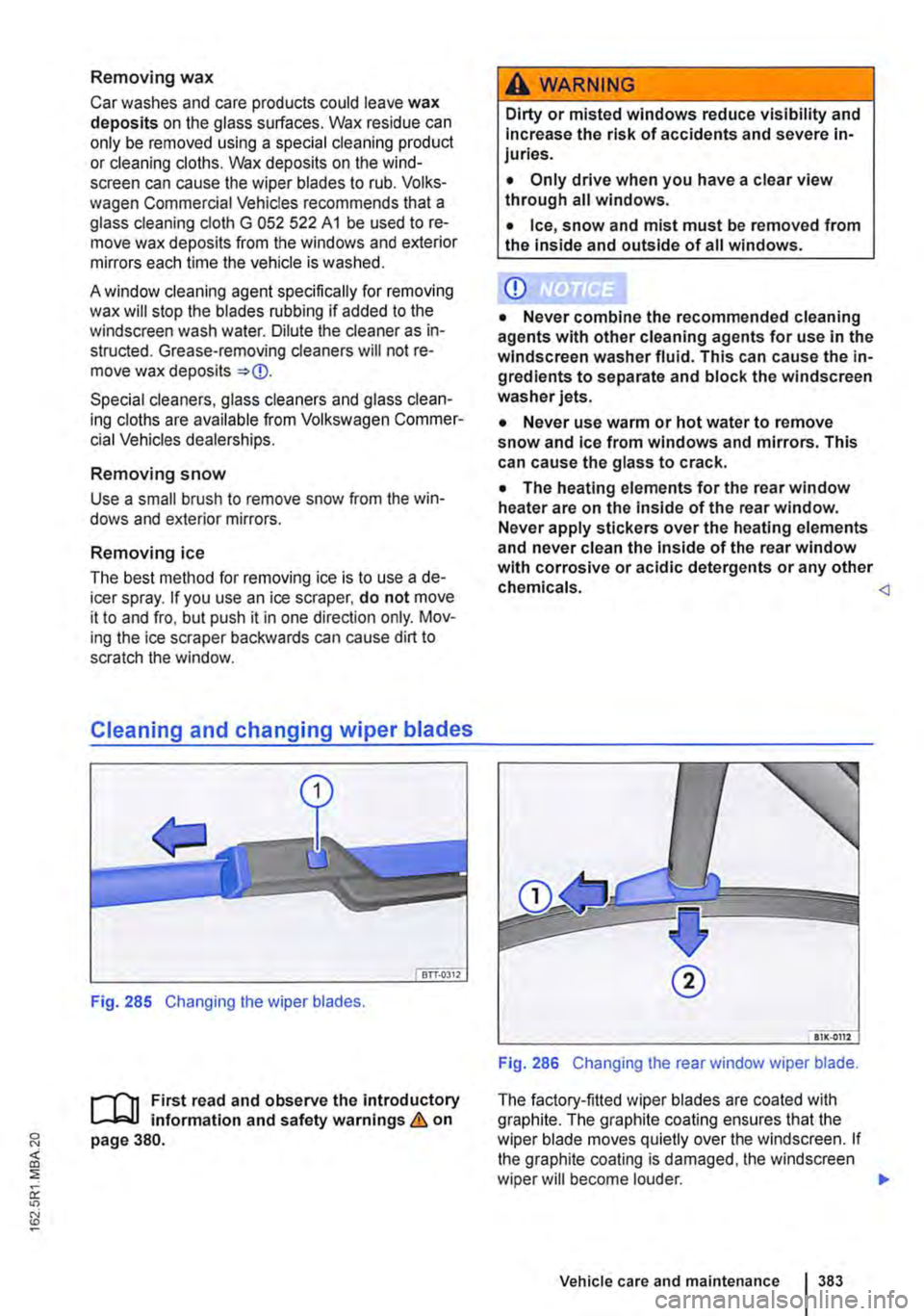
Removing wax
Car washes and care products could leave wax deposits on the glass surfaces. Wax residue can only be removed using a special cleaning product or cleaning cloths. Wax deposits on the wind-screen can cause the wiper blades to rub. Volks-wagen Commercial Vehicles recommends that a glass cleaning cloth G 052 522 A1 be used to re-move wax deposits from the windows and exterior mirrors each time the vehicle is washed.
A window cleaning agent specifically for removing wax will stop the blades rubbing if added to the windscreen wash water. Dilute the cleaner as in-structed. Grease-removing cleaners will not re-move wax deposits =-CD.
Special cleaners, glass cleaners and glass clean-ing cloths are available from Volkswagen Commer-cial Vehicles dealerships.
Removing snow
Use a small brush to remove snow from the win-dows and exterior mirrors.
Removing ice
The best method for removing ice is to use a de-icer spray. If you use an ice scraper, do not move it to and fro, but push it in one direction only. Mov-ing the ice scraper backwards can cause dirt to scratch the window.
Cleaning and changing wiper blades
Fig. 285 Changing the wiper blades.
1"'111 First read and observe the introductory l..-J,:.U information and safety warnings & on page 380.
A WARNING
Dirty or misted windows reduce visibility and Increase the risk of accidents and severe in-juries.
• Only drive when you have a clear view through all windows.
• Ice, snow and mist must be removed from the inside and outside of all windows.
CD
• Never combine the recommended cleaning agents with other cleaning agents for use in the windscreen washer fluid. This can cause the in-gredients to separate and block the windscreen washer jets.
• Never use warm or hot water to remove snow and Ice from windows and mirrors. This can cause the glass to crack.
• The heating elements for the rear window heater are on the Inside of the rear window. Never apply stickers over the heating elements and never clean the inside of the rear window with corrosive or acidic detergents or any other chemicals.
The factory-fitted wiper blades are coated with graphite. The graphite coating ensures that the wiper blade moves quietly over the windscreen. If the graphite coating is damaged, the windscreen wiper will become louder. .,..
Vehicle care and maintenance 383
Page 479 of 486
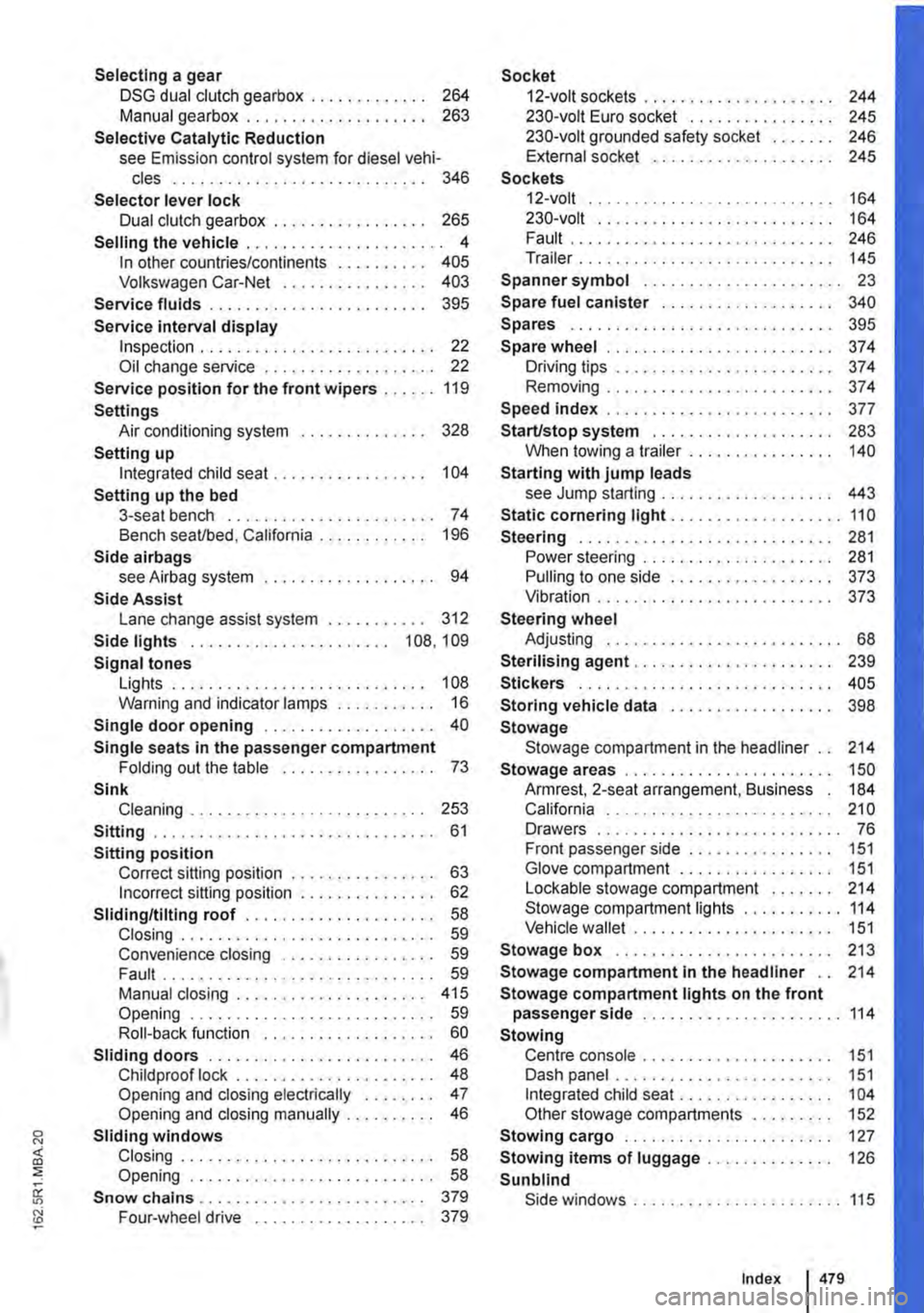
Selecting a gear DSG dual clutch gearbox . . . . . . . . . . . . . 264 Manual gearbox . . . . . . . . . . . . . . . . . . . . 263
Selective Catalytic Reduction see Emission control system for diesel vehi-cles . . . . . . . . . . . . . . . . . . . . . . . . . . . . 346
Selector lever lock Dual clutch gearbox . . . . . . . . . . . . . . . . . 265
Selling the vehicle . . . . . . . . . . . . . . . . . . . . . . 4 In other countries/continents . . . . . . . • . . 405 Volkswagen Car-Net . . . . . . . . . . . . . . . . 403 Service fluids . . . . . . . . . . . . . . . . . . . . . . . . 395
Service interval display Inspection . . . . . . . . . . . . . . . . . . . . . . . . . . 22 Oil change service . . . . . . . . . . . . . . . . . . . 22 Service position for the front wipers ...... 119
Settings Air conditioning system . . . . . . . . . . . . . . 328
Setting up Integrated child seat . . . . . . . . . . . . . . . . . 104
Setting up the bed 3-seat bench . . . . . . . . . . . . . . . . . . . . . . . 74 Bench seaVbed, California . . . . . . . . . . . . 196
Side airbags see Airbag system . . . . . . . . . . . . . . . . . . . 94
Side Assist Lane change assist system . . . . . . . . . . . 312 Side lights . . . . . . . . . . . . . . . . . . . . 108, 109
Signal tones Lights . . . . . . . . . . . . . . . . . . . . . . . . . . . . 108 Warning and indicator lamps . . . . . . . . . . . 16
Single door opening . . . . . . . . . . . . . . . . . . . 40 Single seats in the passenger compartment Folding out the table . . . . . . . . . . . . . . . . . 73
Sink Cleaning . . . . . . . . . . . . . . . . . . . . . . . . . 253
Sitting . . . . . . . . . . . . . . . . . . . . . . . . . . . . . . . 61
Sitting position Correct sitting position . . . . . . . . . . . . . . . 63 Incorrect sitting position . . . . . . . . . . . . . . . 62 Sliding/tilting roof . . . . . . . . . . . . . . . . . . . . . 58 Closing . . . . . . . . . . . . . . . . . . . . . 59 Convenience closing . . . . . . . . . . . . . . . . . 59 Fault . . . . . . . . . . . . . . . . . . . . . . . . . . . . . . 59 Manual closing . . . . . . . . . . . . . . . . . . . . . 415 Opening . . . . . . . . . . . . . . . . . . . . . . . . . . . 59 Roll-back function . . . . . . . . . . . . . . . . . . . 60 Sliding doors . . . . . . . . . . . . . . . . . . . . . . . . . 46 Childproof lock . . . . . . . . . . . . . . . . . . . • . . 48 Opening and closing electrically 47 Opening and closing manually . . 46 Sliding windows Closing ............................ 58 Opening . . . ...................... 58
Snow chains . . . . . . . . . . . . . . . . . . . . . . . . . 379 Four-wheel drive . . . . . . . . . . . . . . . . . . . 379
Socket 12-volt sockets . . . . . . . . . . . . . 244 230-volt Euro socket . . . . . . . . . . . . . 245 230-volt grounded safety socket 246 External socket . . . . . . . . . . . . . . . . 245
Sockets 12-volt . . . . . . . . . . . . . . . . . 164 230-volt . . . . . . . . . . . . . . . . . . . . . . . . . . 164 Fault . . . . . . . . . . . . . . . . . . . . . . . . . . . . . 246 Trailer . . . . . . . . . . . . . . . . . . . . . . . . . . . . 145
Spanner symbol . . . . . . . . . . . . . . . . . . . . . . 23 Spare fuel canister . . . . . . . . . . . . . . . . . . . 340
Spares . . . . . . . . . . . . . . . . . . . . . . . . . . . . . 395
Spare wheel . . . . . . . . . . . . . . . . . . . . . . . . . 374 Driving tips . . . . . . . . . . . . . . . . . . . . . . . . 37 4 Removing . . . . . . . . . . . . . . . . . . . . . . . . . 374 Speed index . . . . . . . . . . . . . . . . . . . . . . • . . 377
Start/stop system . . . . . . . . . . . . . . . . . 283 When towing a trailer . . . . . . . . . . . . . . . . 140
Starting with jump leads see Jump starting . . . . . . . . . . . • . . . . . . . 443 Static cornering light ..........•........ 110
Steering . . . . . . . . . . . . . . . . . . . . . . . . . . . . 281 Power steering . . . . . . . . . . . . . • . . . . . . . 281 Pulling to one side . . . . . . . . . . . 373 Vibration . . . . . . . . . . . . . . . • . . . . . . . . . . 373
Steering wheel Adjusting . . . . . . . . . . . . . . . . . . . . . . . . . . 68
Sterilising agent . . . . . • . . . . . . . . • . . . . . . . 239
Stickers . . . . . . . . . . . . . . . . . . . . . . . . . . . . 405
Storing vehicle data . . . . . . . . . . . . . . . . . . 398
Stowage Stowage compartment in the headliner . . 214 Stowage areas . . . . . . . . . . . . . . . . . . . . . . . 150 Armrest, 2-seat arrangement, Business . 184 California . . . . . . . . . . . . . . . . . . . . . . . . . 210 Drawers ........................... 76 Front passenger side . . . . . . . . . . . . . . . . 151 Glove compartment . . . . . . . . . . . . . . . . . 151 Lockable stowage compartment . . . . . . . 214 Stowage compartment lights ........... 114 Vehicle wallet . . . . . . . . . . . . . . . . . . . . . . 151
Stowage box . . . . . . . . . . . . . . . . . . . . . . . . 213
Stowage compartment in the headliner . . 214 Stowage compartment lights on the front passenger side ...................... 114 Stowing Centre console . . . . . . . . . . • . . . . . . . . . . 151 Dash panel . . . . . . . . . . . . . . . . . . . . . . . . 151 Integrated child seat . . . . . . . . . . . . . . . . . 104 Other stowage compartments . . . . . . . . . 152 Stowing cargo . . . . . . . . . . . . . . . . . . . . . . . 127 Stowing items of luggage . . . • . . . . . . . . . . 126
Sunbllnd Side windows . . . . . . . . . . . . . . . . . . . . . . . 115
Index I 479